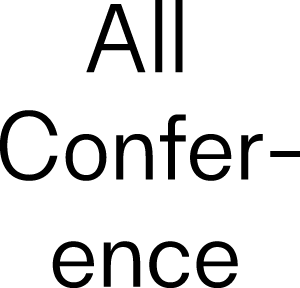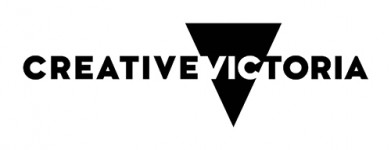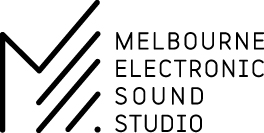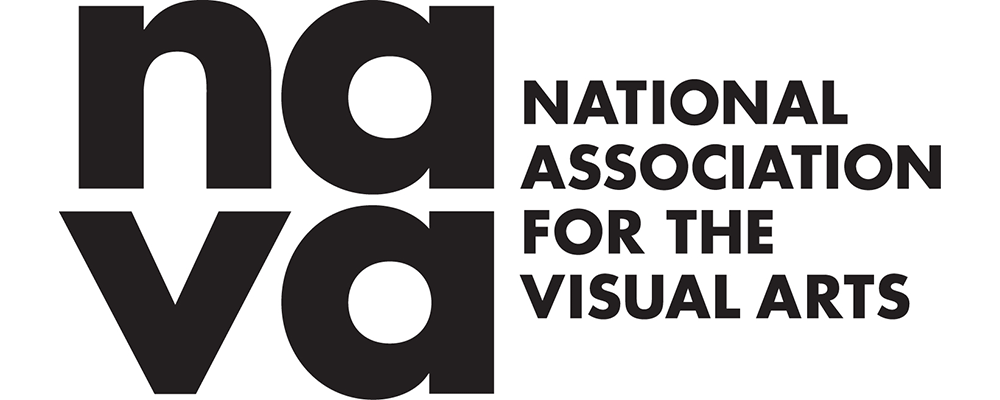Liquid Architecture (LA) is Australia’s leading organisation for artists working with sound and listening. LA is based on Wurundjeri Woi Wurrung Country, at the Collingwood Yards art precinct. Our program sits at the intersection of contemporary art and experimental music, expressed through a range of presentation, publishing, research and commissioning activities.
BACKGROUND
Born in the complex artistic climate of the late 1990s, LA is a millennial imagination of Australia’s vibrant experimental sound culture. Founded in 1999, over the following 15 years, under the direction of Nat Bates, LA grew from being a boutique local event into Australia’s leading festival of experimental, electronic, improvised and avant-garde music.
In 2014, the organisation pivoted with an injection of ideas and resources, and the appointment of Joel Stern and Danni Zuvela as the organisation’s artistic leadership. The duo dissolved the festival model in favour of something more open, unpredictable and experimental: a year-round, curatorial program of boundary-pushing public events, happenings and situations untethered to any one discipline, ideology or format.
Forever expanding and evolving to meet our horizons, the cultural institution we know today as Liquid Architecture is fuelled by the ideas and energies of our team and augmented by the expertise of our board and advisors.
Under the leadership of Kristi Monfries alongside Creative Producer Rohan Rebeiro, Creative Producer James Howard and Programs Coordinator Ronen Jafari, the new direction will expand on this legacy to build strong foundations and relationships with sound experimentations from First Nations, Diasporas, Asia and the Pacific.
Grounded locally but working globally, LA is a dedicated platform for artists engaged in experimental sound practice, sustained and energised through conversation and research, and realised in collaboration with people in our community and beyond.
We acknowledge the Wurundjeri Woi Wurrung as the Traditional Owners and sovereign custodians of the Country on which we practice. We extend our respects to their Elders past and present, and to all First Peoples.
Team
BOARD
DANNY BUTT (CHAIR) is Senior Lecturer in Interdisciplinary Practice at Victorian College of the Arts, University of Melbourne, where he is also Coordinator of Research for Design and Production. His book Artistic Research in the Future Academy was published by Intellect/University of Chicago Press in 2017, and he is on the Editorial Board of the Journal for Artistic Research and is co-convenor of the Asia Pacific Artistic Research Network. As a Certified Management Consultant (CMC) he worked for intergovernmental agencies such as United Nations Development Programme and ASEAN on new media and development and was editor of the book Internet Governance: Asia Pacific Perspectives (Elsevier/UNDP 2006). He works with the Auckland-based art collective Local Time. He moved from Gadigal country in Sydney to Port Chalmers / Koputai, Aotearoa New Zealand in 1993, performing improvised sound and releasing recordings through the 1990s with Peter Stapleton and Kim Pieters in the groups Rain and Flies Inside the Sun (with Brian Crook); with Michael Morley in the Tanaka-Nixon Meeting; and as Cobweb Iris.
REBECA SACCHERO (DEPUTY-CHAIR)
Rebeca Sacchero is a Producer with extensive experience across multiple Metro Melbourne Inner North Local Government Areas. Rebeca understands the local government context whilst also having relationships and experience in small to medium arts orgs. She has been working in the space of community engaged practice and is passionate about creating arts access for under-represented communities. She has a strong track record of successful projects with youth, the LGBTQIA+ community, CALD communities and seniors. She has worked across visual arts, performing arts and digital media, with a range of government and private stakeholders. These include major festivals, local and state Government, ARI’s, schools, community health orgs, and social enterprises. She completed a degree in Art History and Curatorship at Monash University in 2017 and in 2019 was selected for Leadership Victoria’s LGBTQIA+ Leadership program. She also runs her own community building electronic music events in which she has toured international artists, and is a DJ.
MARK NOLEN (TREASURER) is a Certified Practising Accountant with extensive experience in the creative industries sector. He is currently Management Accountant at ACMI, having previously worked in a similar role at Film Victoria. Along the way, he has helped countless singers, actors, and even clowns get their taxes in order – no laughing matter! When not crunching numbers, you can find Mark sitting back with a fine drop of Scotch whisky, soaking up some even finer tunes.
CLAIRE BREDENOORD (SECRETARY) is an education designer and creative producer with experience in non-profit arts organisations, higher education and start-ups. She has a background in socially engaged arts practice and publishing, most often working across disciplines to produce multimodal projects. Most recently, Claire has contributed to the launch of Industri Education, a live music education organisation aiming to provide pathways into industry, as the Operations and Education Lead. A notable achievement has been collaborating with live music industry stakeholders to design new courses in technical production. Claire holds a Juris Doctor and a Master of Arts and Community Practice. She aims to continue developing her diverse skill set and passion for relational community practice to contribute to First Nations peoples’ fight for justice.
MONICA LIM (MEMBER) is a Melbourne-based pianist and composer of classical contemporary and experimental music. Born in Malaysia and then migrating to Australia in her teens, Monica initially practiced as a Tax Consultant for Deloitte Touche Tohmatsu, before pursuing her own interests in business and the arts. She has produced work for theatre, contemporary dance, installations, and film, as well as solo and ensemble instrumental pieces. She is interested in new cross-disciplinary genres and forms as well as combinations of new technology with music. Monica is currently undertaking a PhD at the Faculty of Fine Arts and Music, University of Melbourne in interactive technology, AI and gesture-led composition. Monica is co-founder of Project Eleven, a philanthropic initiative which supports the contemporary arts and serves on the boards of the Melbourne Recital Centre, the Substation as well as the Member’s Council for Musica Viva.
NARETHA WILLIAMS (MEMBER) is an accomplished practitioner in the Australian creative industries sector. An established artist and music producer, she is a seasoned industry professional with extensive experience across a dynamic range of appointments. Naretha has worked with leading Australian companies and First Nations initiatives, flagship festivals and events, has toured internationally and won several awards. Credits include: St Kilda Festival, Bless Your Blak Arts Festival, Australasian World Music Expo, International Symposium on Electronic Art, Yirramboi First Nations Arts Festival, Science Gallery London, Chunky Move, Performance Space New York, The Melba Spiegeltent, Melbourne Town Hall Grand Organ, Sydney Myer Music Bowl, Sydney Dance Company, and Melbourne’s Flash Forward.
GAIL PRIEST (MEMBER) is a sound artist and writer based on Dharug and Gundungurra land (Katoomba, NSW). Her work spans soundtracks for dance, theatre and video, solo electro-acoustic performance as well sound installations for gallery contexts, both solo and in collaboration. She has performed her live compositions and exhibited sound installations nationally and internationally including in Japan, Hong Kong, Germany, France, Norway and the Netherlands. In 2015-16 she was awarded an Emerging & Experimental Arts Fellowship from the Australia Council. She has undertaken numerous radio commissions and releases music on her own label Metal Bitch Recordings as well as Flaming Pines, Endgame Records and room40. She curates events and exhibitions and writes fictively and factually about sound and media art, working for RealTime magazine for over 15 years. She has been on the board of Performance Space (2011-2014), and a peer assessor for the Australia Council. She has just completed a PhD in creative sound theory at UTS. www.gailpriest.net
DAVID CHESWORTH (MEMBER) is an artist and composer, known for his experimental, and at times minimalist music, who has worked with electronics, contemporary ensembles, film, theatre, and experimental opera. Together with Sonia Leber, David has created installation artworks using sound, video, architecture and public participation. Exhibitions include ‘56th Venice Biennale (2015), ‘19th Biennale of Sydney (2014), and Melbourne Now, National Gallery of Victoria, Melbourne (2013-14). Festivals featuring Chesworth’s music and sound works include Ars Electronica; Festival D’Automne de Paris; Bang on a Can Marathon, New York, Biennale of Sydney; Adelaide and Melbourne Festivals; and MONA FOMA. Early in his career he was co-founder of post-punk band Essendon Airport and for five years was coordinator of the Clifton Hill Community Music Centre, Melbourne. David is a Vice-Chancellor’s Postdoctoral Fellow at RMIT University, Melbourne, researching auditory archives.
STAFF
Kristi Monfries (CEO + Director)
Rohan Rebeiro (Senior Creative Producer)
Ronen Jafari (Programs Manager)
James Howard (Creative Producer: First Nations Programming)
Bianca Winataputri (Editor - Disclaimer)
LA ASSOCIATES
Laura McLean and Suvani Suri (Associate Curators - Capture All)
Helen Grogan (Associate Advisor - Liquid Archive)
INTERNS
Maresca Hidayat
Olivia Stephen
Jess Phillips
Contact
We welcome conversation, ideas and feedback at any time.
info@liquidarchitecture.org.au
TW, FB, IG, YT, MX, SC
Journal, Podcast
104/35 Johnston Street
Collingwood VIC 3066
AUSTRALIA
LIQUID ARCHITECTURE
SOUND INC
ABN 73128090237
ASN A0050679K
Privacy Statement
Liquid Architecture (LA) is committed to protecting the privacy and security of personal information obtained and stored about its audience or clientele, including users of this website.
We understand and appreciate that our audience or clientele and users of this website are concerned about their privacy and the confidentiality and security of any information that may be provided to us.
This policy applies when Liquid Architecture determines what information will be collected or disclosed, or how any information will be processed.
We take a broad understanding of what constitutes ‘personal information’. We understand ‘personal information’ to include any information relating to an identified or identifiable natural person. An identifiable natural person is one who can be identified, directly or indirectly, in particular by reference to an identifier such as a name, an identification number, location data, an online identifier or to one or more factors specific to the physical, physiological, genetic, mental, economic, cultural or social identity of that natural person.
Liquid Architecture is bound by the Australian Privacy Principles contained in the Commonwealth Privacy Act and is compliant with the Privacy Amendment (Enhancing Privacy Protection) Act 2012.
We may, from time to time, review and update this Privacy Policy to take account of new laws and technology, changes to Liquid Architecture’s operations and practices and to make sure it remains appropriate to the changing legal environment.
THE TYPES OF PERSONAL INFORMATION LA COLLECTS
The type of information Liquid Architecture collects and holds includes (but is not limited to) personal information, including sensitive information, about:
- Contact information including email address, phone number, names, gender, organisation, role.
- Connection information including linkages and referrals between people.
- Financial information including amounts paid to LA, donated to LA, or received by LA.
- When you visit our website, our server maintains an access log that includes the following information: the visitor’s IP address, the date and time of the visit to the site, the pages accessed and documents downloaded, the previous site visited, and the type of browser used.
- When you visit our website, cookies are stored on your device that provides information to Google Analytics to give us statistical information about our visitors.
HOW PERSONAL INFORMATION IS COLLECTED
LA collects personal information in a variety of different ways depending on the type of contact that is made with the organisation. We collect personal information both from individuals directly and from third parties.
- Subscribing to LA’s newsletter via the website, in-person or other means
- Visiting LA’s website
- Registering for LA’s programs of events (eg. performances, workshops, lectures)
- Purchasing a ticket for LA’s programs of events via a ticketing system
- Making an online enquiry
- Making an individual donation to LA
- Becoming a sponsor
- Submitting a proposal to LA
- Providing written feedback to LA
- Through agreements with programming partners to add addresses to our mailing lists
- Images of persons might be collected during documentation of an LA performance
- If you become a LA Associate, Volunteer or Board Member
LA may also collect personal information over the phone, in person or by electronic correspondence in order to undertake its regular administrative operations
WHY PERSONAL INFORMATION IS COLLECTED
LA collects personal information in order to service the needs of its staff, audience and partnerships. This information is only used with your consent. Your personal information may be retained and used for the following purposes:
- To communicate with staff, artists, associates, volunteers, or Board Members
- For communicating about upcoming programs and services offered by LA and its partners
- For documenting LA performances and events
- To communicate to LA audiences on behalf of other arts or government organisations offering information regarding their products
- For artistic program research and organisational continuous improvement purposes
All details are kept secure at all times and any individual may request their information is not used for direct marketing, research or any other purpose.
DISCLOSURE OF PERSONAL INFORMATION
LA will not sell, lend, disclose, or give personal information of its audience or clientele to external individuals or organisations without first obtaining the customer’s consent.
LA may, however, disclose your personal information or financial data (information exchanged in transactions relating to donations, ticket purchasing or any other product sold):
- To our insurer or legal advisors for the purpose of obtaining insurance coverage, obtaining professional advice, and managing risks.
- To our payment services providers or financial institutions. LA will share transaction data only to the extent necessary for processing, refunding, or dealing with queries about payments.
- In a situation where such disclosure is necessary for compliance with a legal obligation that LA is subject to, or in order to protect the vital interests of a person.
LA will not disclosure personal information to recipients in another jurisdiction unless that jurisdiction has a privacy regime at least as equally protective as Australia. LA will always ask for specific consent before disclosing personal information to a recipient in another jurisdiction.
PERSONAL INFORMATION ACCURACY
LA is committed to ensuring all personal information it collects is accurate, complete and up-to-date. However, the accuracy of this personal information to a large extent depends on the information provided by its clients. LA asks that all clients:
- Advise us if you become aware of any errors in your personal information.
- Advise of any changes in their personal details, such as address, email address and phone number.
YOUR RIGHTS
At any time, any person has the right:
- To know what personal information LA holds about them and how it has been used
- To correct or alter any personal information LA holds about them
- To have the personal information about them erased
- To withdraw consent for the collection, retention, disclosure, use or processing of personal information
- To make a request or inquiry, write to info@liquidarchitecture.org.au
WEBSITE
The LA website contains links to other sites. LA is not responsible for the privacy practices of other sites. LA encourages users when they leave the site to read the privacy statements of each and every web site that collects personal information. This privacy statement applies solely to the activities of LA.
GENERAL DATA PROTECTION REGULATION (GDPR)
LA operates occasional European artistic programming and partnerships, and complies with the data protection policies required by the European Union General Data Protection Regulation (the GDPR) since 25 May 2018.
OUR DATA SECURITY POLICY
LA takes steps to prevent the personal information it holds from misuse, loss, interference or unauthorised access.
LA will also destroy or de-identify personal information when it is no longer needed, or when requested.
ENQUIRIES
If you would like further information about the way Liquid Architecture manages the personal information it holds, please contact LA via info@liquidarchitecture.org.au.
Feedback & Complaints
Liquid Architecture (LA) is committed to respecting feedback and complaints and continually improving our processes. This policy is intended to ensure that we handle complaints fairly, efficiently and effectively. We encourage feedback as part of improving our audience experience and artistic programming.
You can provide feedback or make a complaint via email via email to info@liquidarchitecture.org.au.
HOW DOES LA HANDLE FEEDBACK AND COMPLAINTS?
Upon receiving feedback or a complaint, LA will acknowledge receipt of the feedback or complaint; and request further information if necessary and advise how the issue is likely to be resolved.
LA will not respond to feedback or complaints that violate State or Federal laws, or suggest that others do so; contain profane, violent, abusive, sexually explicit language or hate speech; or are bullying, harassing or disruptive in nature.
Where possible, complaints will be resolved at first contact with us. When appropriate we may offer an explanation or apology to the person making the complaint. Where this is not possible, we may decide to escalate the complaint to LA’s CEOs or Board. Where a person making a complaint is dissatisfied with the outcome of our review of their complaint, they may seek an external review of our decision.
We will take all reasonable steps to ensure that people making complaints are not adversely affected because a complaint has been made by them or on their behalf.
All complaints are confidential. We accept anonymous complaints if there is a compelling reason to do so and will carry out a confidential investigation of the issues raised where there is enough information provided.
HOW LONG WILL IT TAKE FOR MY COMPLAINT TO BE RESOLVED?
The time it takes to resolve a matter depends on the issues raised and any enquiries that need to be made. As a guide, LA aims to acknowledge written feedback and complaints within 1 business day of receipt (if an email address or phone number is provided); respond to all written feedback and complaints within 5 business days of receipt.
LA will consider the matter closed if you indicate that you are satisfied with the response, or LA does not hear from you within 10 business days after sending you its response.
WHAT IF I’M NOT HAPPY WITH THE RESPONSE?
If you are dissatisfied with LA’s response you are encouraged to contact LA to request an internal review. You should outline in writing why you are dissatisfied with the response; and the outcome you are seeking. LA will provide a further response within 10 business days of receiving this information.
If you are dissatisfied with the outcome of our review of their complaint, you may seek an external review of our decision (by the Australian Charities and Not-for-Profits Commission for example).
Australian Charities and
Not-for-Profits Commission
Advice team: 13 22 62
Online Form
TICKET REFUNDS AND EXCHANGES
LA may provide an exchange or refund of a ticket if problems arise before, during or after an event. LA encourages our audience to try to resolve problems as soon as possible after they arise so that we have the best opportunity to find a solution.

The Audio-Spectator
Michel Chion
Born in 1947, Michel Chion is a composer, filmmaker, historian and writer – and arguably the world’s foremost thinker on sound in cinema.
In the 1970s he was a member of the Groupe de Recherches Musicales (GRM), the influential collective led by composer and theoretician Pierre Schaeffer dedicated to furthering the art of ‘musique concrète’ through experiments in audiovisual communication, audible phenomena and music in general. It was at the GRM that Chion composed arguably his most famous work, Requiem, a noisy and surreal deconstruction of the Funeral Mass made whilst pondering the “troubled minority of the living, rather than the silent majority of the dead.”
Since the 1980s, Chion has written extensively on the relationship of sound and image in the cinema, publishing in 1990 what many consider the definitive theoretical guide to the subject, Audio-Vision: Sound on Screen. In this momentous book, Chion advances a whole new lexicon for describing audio-visual concepts, via the works of Jacques Tati, Alfred Hitchcock, Jean-Luc Godard and others. On reading, film scholar Claudia Gorbman was moved to name him “a poet in theoretician’s clothing.”
For this program, Michel Chion will perform an epic two-and-a-half-hour concert for ten surround-speakers featuring the classic composition Requiem (1973) alongside two new audiovisual compositions, The Scream (2017), and Third Symphony (2016).
notes by Michel Chion
A CONCERT IN TWO PARTS
1: LE CRI, 2017, 17 ‘ and REQUIEM, 1973, 37’26
2: THIRD SYMPHONY, audio-divisive, 2016, 88 ‘
The first part of this concert comprises two works of musique concrète for ‘fixed’ sounds, with the projection of a blank image, intended to create a listening frame and to display the English subtitles of the text that is heard. The second part proposes an “audio-divisive” music, consisting of silent images, sounds on a blank background, and images and sounds synchronised in different ways.
 Image: Michel Chion, R. Cahen and R. Cochini at GRM, 1974
Image: Michel Chion, R. Cahen and R. Cochini at GRM, 1974
LE CRI (The Scream)
Musique concrète for two-track video-audio 2017.
World Premiere. 17 ‘
By definition, in musique concrète (that is, music for fixed sounds), anything can arise at any moment from the loudspeaker, sounds from which we can not be protected—since we possess no natural eyelids for sound—but also sound with no frame, which spreads into space, even when it comes from a single source. The scream will not be heard much, but the scream will be awaited; it will be proposed in small pieces, as when one revolves around a sculpture, a volume. My project is to make a work in which there is no impression of a linear discourse, but rather the exploration of a space while maintaining a great tension. But it is not a tragic scream (as in the famous painting of Edvard Munch), rather a scream of life ….
This work was done in my personal studio, combining the tape recorder (for creating sounds) and the computer (for final editing). It is presented in a new form: with a title on a black screen and in silence, to create an ‘interval’ of time before the work begins, and to allow the work to begin in an atmosphere of concentration. The screen then remains black throughout the duration of the listening.
M.C., April 9, 2017

REQUIEM
Musique concrète for two-track video-audio. In two stages and ten movements, based on texts of the Mass of the Funerals 1973.
First performance of the version with English subtitles. 37’26”
Requiem as a whole is built on a system of echoes and correspondences that seem to be symmetrically organised around an axis represented by the work’s middle point. The form was developed in the course of the process, as a dramatic scheme that played off the listener’s memory and premonitions, since once the listener has heard the work more than once, they can predict as well as recall. Echoes and correspondences of what? Themes, musical motives, ranging from the most elemental (a loop, raw matter) to the most elaborated (a musical development), and which are reprised, quoted or announced at various moments of the work – some are easily identifiable as “leitmotivs” (theme-chorus from the Dies Irae quoted in the finale), while others are accompanying motives, matter that does not need to be memorised at a conscious level. An extreme case of such echo effect is found in the short movements 2 & 9, which use almost the same “music” cast under completely opposite sound lighting. The centre of the work, the axis of that symmetry, is the 6th movement Evangile, where happens a symbolical tear in the magnetic tape, a crack in the work itself, opening in the timeline a breach of eternity that lets us glimpse “something else.”
Within this large form in two parts, we find the small forms of each movement: forms with choruses and episodes, litanies, recitativo, levelled crescendos, etc. There is also another formal course delineated by the succession of several vocal characters, their timbre, intonation, and relation to the libretto. The only time a well-assured, peremptory voice is clearly heard is, once again, at that central moment in Evangile (“il va ressusciter” or “he will rise”), where its irruption seems to spread panic throughout the whole system and provoke the breach…
Like the requiems of the classical era, this Requiem‘s text is taken from the Funeral Mass, to which are added an Epistle, a Gospel and a Pater Noster. The texts are mostly said in their original language (Latin or Greek) and in French, in some rare cases. The Requiem was composed whilst thinking about the troubled minority of the living, rather than the silent majority of the dead. I tried to turn this oratorio into a “great sonic show,” cinemascope music. One can detect the obvious (at least to me) influence of filmmakers and films, more in the play of forms, time and space, as opposed to realistic evocations. Thomas Mann’s Doktor Faustus was an influence, again acknowledged after the fact; the pages spent describing the imaginary works of Adrian Leverkühn might have inspired the megalomaniac dream of carrying bits and pieces of them into the sound world.
With Requiem, my intention was not to deliver a message or a manifesto, whether pro- or anti-religious. Instead, this work is a personal testimony, into which listeners are invited to project their own self, if they care to inhabit it with their own experience and sensibility.
M.C., 1978
1er temps: 1. Introït – 2. Kyrie Eleison – 3. Epître – 4. Dies Irae – 5. Offertoire – 6. Evangile
2ème temps: 7. Sanctus – 8. Agnus Dei – 9. Lux aeterna – 10. Libera me
Voices: André Allag, Michèle Bokanowski, Caroline, Laure et Pierre Bruas, Robert Cahen, M.C., Catherine Colas, Jean-Pierre Colas, Catherine Guérin, Bernard Guillochon, Geneviève Julien-Labruyère, L’Ensemble vocal Le Madrigal, dir. Rachid Safir.
Production: GRM
 Image: Michel Chion and Pierre Schaeffer presenting the Guide to Sound Objects, 1984
Image: Michel Chion and Pierre Schaeffer presenting the Guide to Sound Objects, 1984
THIRD SYMPHONY, Audio-divisive
Work on video-audio for fixed sounds (two tracks) and fixed images (one screen), in ten movements. 2016.
First performance of the version with English subtitles. 1h28 ‘
After two symphonies of musique concrète, including La Vie en Prose, 2010 (published by Brocoli), I wanted to create an “enlarged” symphony with projected images, in the manner that the Ninth of Beethoven or the Third of Mahler were expanded with solo singers and choirs. Despite the high number of movements, the symphonic form is prevalent: a very developed Scherzo, a Largo desolato which corresponds to a slow and funereal meditation, and a last movement that functions like a Finale. And above all, the term symphony embodies the idea of a work, which has meaning only as a composition, a whole.
I have invented the term “audio-divisive” to make it clear that what I called “audio-vision” in 1990, that is, the perception of simultaneous sounds and images, is certainly more than a simple addition, but also the opposite of a fusion where everything would amalgamate. In this work, sounds and images are proposed together or separately: certain movements are acousmatic (without vision of the source), other athorybes (moving images without corresponding sounds), the majority audio-divisive, according to various formulas. For example, in the Café movement, where I capture a whole five minutes of images and sounds from a Parisian bistro, without changing anything, we have audio-division in the roughest sense of everyday experience, since most of what is heard – the boss, customers – happens outside the visual field, while the sound of much of what we see through the glass is masked by this barrier, and by the urban uproar!
Within this Third Symphony, I also wanted to share my Earth Mass (1992-96), which is rainy, slow and meditative, more solar and familiar, with no religious references. The beautiful “questions of children” discussing with their teacher in the movement VIII, are questions of everyone and for everyone, and give spirit to this work.
M.C., summer 2016
1. Floating element, prologue (audio-divisive)
2. Generic (athorybe)
3. Allegro Animato (mainly acousmatic)
4.5.6. Three interiors: Café (audio-divisuel) – Studio (athorybe) – Room (audio-divisuel)
7. Scherzo Vivace in ten variations (audio-divisive)
8. Intermezzo Anatoribico (audio-divisive)
9. Largo Desolato in memory of Christiane Sacco, writer (1939-1999) (acousmatic)
10. Final, in four external (audio-divisive).
Sound and visual creation, editing and production: M.C.
With the precious help, for the digital finishing, of Jérôme Bloch and Geoffroy Montel.
Commissioned by Motus for the Futura Festival, August 2016 in Crest, France.
Program in partnership with the Australian Cinémathèque, QAGOMA and Institut Français****

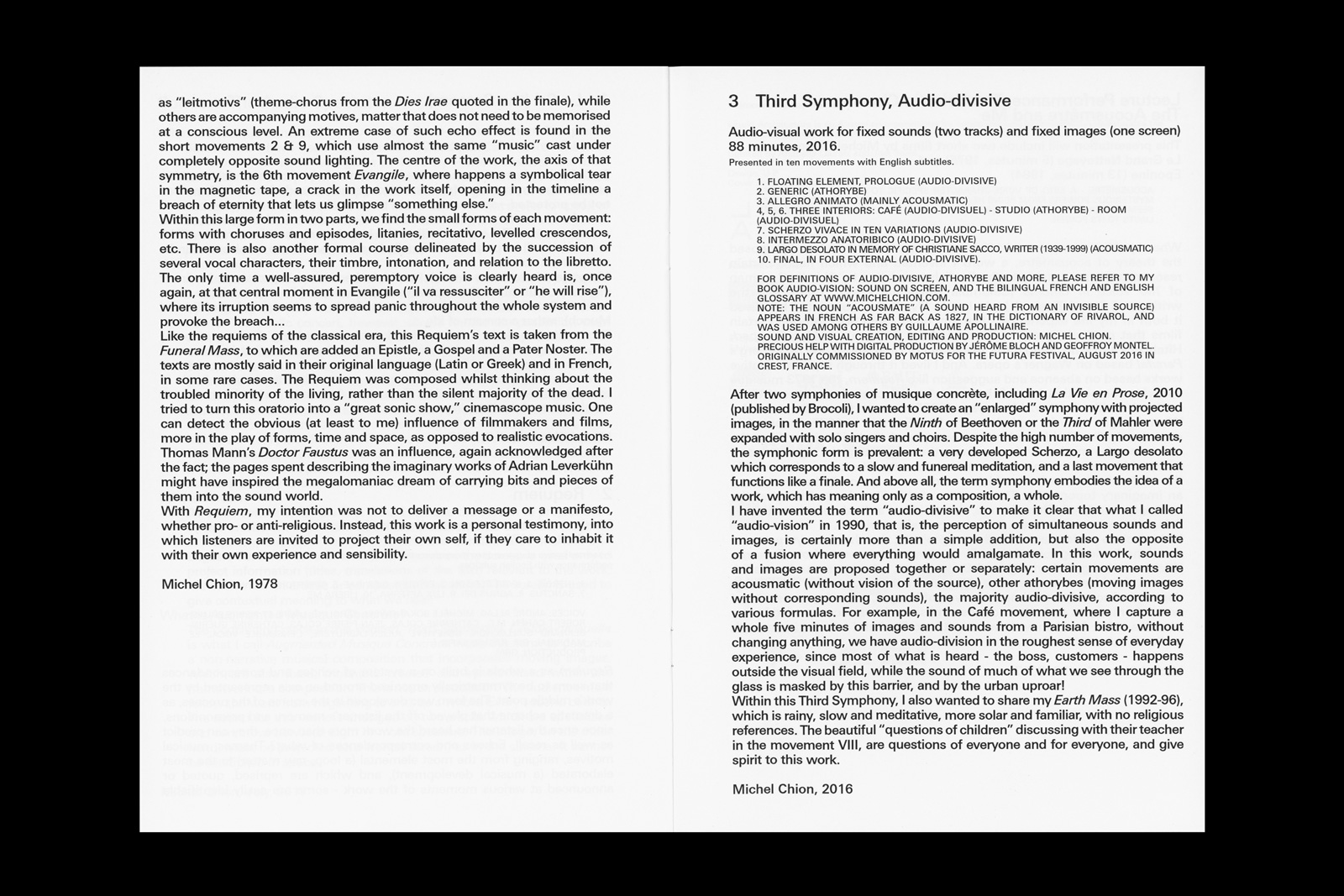

Print material designed by U-P
We acknowledge the Turrbal and Jagera people as the custodians of the land in which this event takes place, and we recognise that sovereignty was never ceded. We pay our respects to their Elders, past, present and emerging.Partners
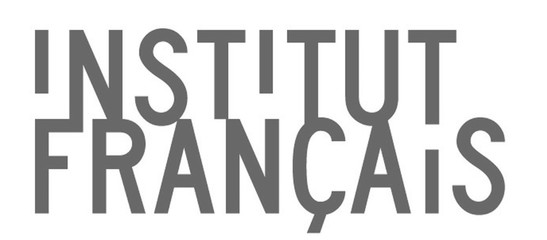

Michel Chion
Born in 1947, Michel Chion is a composer, filmmaker, historian and writer – and arguably the world’s foremost thinker on sound in cinema.


